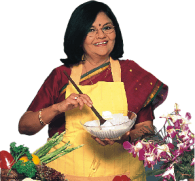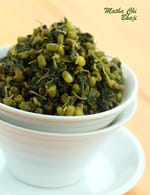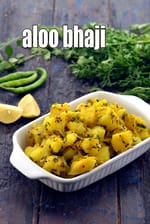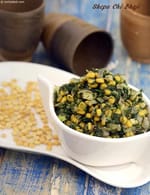You are here: Home> Cuisine > Indian Veg Recipes > Maharashtrian recipes > Maharashtrian Bhaji > Maharashtrian Patal Bhaji, Paatal Bhaji
Maharashtrian patal bhaji recipe | palak ki patal bhaji | healthy patal bhaji |
Table of Content
Maharashtrian patal bhaji recipe | palak ki patal bhaji | healthy patal bhaji | with step by step images.
patal chi bhaji is a nourishing daily fare which can be enjoyed by people of all ages. Learn how to make Maharashtrian patal chi bhaji.
To make Maharashtrian patal bhaji, combine the chana dal, colocasia leaves and 1½ cups of water in a pressure cooker, mix well and pressure cook for 3 whistles. Allow the steam to escape before opening the lid. Keep aside. Heat the oil in a non-stick kadhai, add the mustard seeds, cumin seeds, asafoetida and sauté on a medium flame for a few seconds. Add the prepared paste and sauté on a medium flame for 2 minutes. Add the chana dal-colocasia leaves mixture, tamarind pulp, jaggery, peanuts and salt, mix well and cook on a medium flame for 3 minutes, while stirring occasionally. Serve hot.
Colocasia leaves are frequently used in Maharashtrian and Gujarati cooking, not only for their unique flavour but for their nutritional benefits as well. Palak ki patal bhaji, made with colocasia leaves and chana dal, perked up with a special coconut-based masala, is a treat to your palate with its interesting sweet-and-sour flavour.
Patal chi bhaji is a great dish to have during all three trimesters of pregnancy when a woman’s iron requirements are very high. This Patal bhaji is also an excellent source of protein, folic acid and fiber. Fibre is needed to keep constipation at bay – a common problem faced during pregnancy. Iron and folic acid are needed for baby’s growth and development.
Healthy patal bhaji gets its share of iron and folic acid from colocasia leaves and protein from chana dal. It gains both soluble and insoluble fiber from these 2 ingredients. Moreover, the vitamins A and C act as antioxidants and maintain cell health.
Heart patients and those with high cholesterol can also enjoy this palak ki patal bhaji as a part of their daily meal. Prefer to reduce the quantity of jaggery or eliminate it completely from the recipe. Enjoy it with hot phulkas to make a healthy meal!
Tips for maharashtrian patal bhaji. 1. Wash the colocasia leaves very well to get rid of all the dirt. 2. Prefer grated coconut than roughly chopped to make so as to get a smooth paste. 3. Do not over cook the chana dal. It should lend a good mouth feel.
Enjoy Maharashtrian patal bhaji recipe | palak ki patal bhaji | healthy patal bhaji | with step by step photos.
Maharashtrian Patal Bhaji, Paatal Bhaji recipe - How to make Maharashtrian Patal Bhaji, Paatal Bhaji
Tags
Soaking Time
0
Preparation Time
10 Mins
Cooking Time
21 Mins
Baking Time
0 Mins
Baking Temperature
0
Sprouting Time
0
Total Time
31 Mins
Makes
4 servings
Ingredients
For Maharashtrian Patal Bhaji
- 2 1/2 cups chopped colocasia leaves (arbi ke patte)
- 1/4 cup chana dal (split Bengal gram) , washed and drained
- 2 tsp oil
- 1/2 tsp cumin seeds (jeera)
- 1/2 tsp mustard seeds ( rai / sarson)
- 1/4 tsp asafoetida (hing)
- 2 tsp tamarind (imli) pulp
- 1 tbsp chopped jaggery (gur)
- 2 tbsp roasted and coarsely crushed peanuts
- salt to taste
To Be Ground Into A Smooth Paste ( Without Using Any Water)
- 2 tbsp grated coconut
- 1 1/2 tsp roughly chopped green chillies
- 1/4 cup chopped coriander (dhania)
Method
- Combine the chana dal, colocassia leaves and 1½ cups of water in a pressure cooker, mix well and pressure cook for 3 whistles.
- Allow the steam to escape before opening the lid. Keep aside.
- Heat the oil in a non-stick kadhai, add the mustard seeds, cumin seeds, asafoetida and sauté on a medium flame for a few seconds.
- Add the prepared paste and sauté on a medium flame for 2 minutes.
- Add the chana dal-colocassia leaves mixture, tamarind pulp, jaggery, peanuts and salt, mix well and cook on a medium flame for 3 minutes, while stirring occasionally.
- Serve hot.
Maharashtrian Patal Bhaji, Paatal Bhaji recipe with step by step photos
-
- If you like Maharashtrian patal bhaji, then also try other healthy sabzi like
-
-
For the paste of Maharashtrian patal bhaji, grate the coconut first.
-1-190025.webp?w=800&format=webp)
-
Then roughly chop the green chillies.
-2-190025.webp?w=800&format=webp)
-
Clean, wash and chop the coriander also.
-3-190025.webp?w=800&format=webp)
- Combine all 3 in a mixer jar and blend to a smooth paste without using water. Keep aside.
-
For the paste of Maharashtrian patal bhaji, grate the coconut first.
-
-
To make Maharashtrian patal bhaji recipe | palak ki patal bhaji | healthy patal bhaji, we need colocassia leaves. Look for bright green leaves which are fresh, not limp.
-1-190026.webp?w=800&format=webp)
-
Wash and clean them and place on a chopping board and chop them. These are copped colocasia leaves.
-2-190026.webp?w=800&format=webp)
-
Then clean and wash the chana dal and add it to a pressure cooker.
-
Add the chopped colocasia leaves.
-
Add 1½ cups of water for cooking.
-
Mix well and pressure cook for 3 whistles. Allow the steam to escape before opening the lid. Keep aside.
-6-190026.webp?w=800&format=webp)
-
Then to make palak ki patal bhaji, heat the oil in a non-stick kadhai.
-
Add the mustard seeds to it.
-
Also add cumin seeds for tempering.
-9-190026.webp?w=800&format=webp)
-
Add little asafoetida. This aids in digestion.
-10-190026.webp?w=800&format=webp)
-
Sauté on a medium flame for a few seconds. They should crackle.
-11-190026.webp?w=800&format=webp)
-
Once the seeds crackle, add the prepared coconut-coriander paste.
-
Sauté the paste on a medium flame for 2 minutes.
-13-190026.webp?w=800&format=webp)
-
Add the chana dal-colocassia leaves mixture.
-
Add tamarind pulp for slight tang.
-15-190026.webp?w=800&format=webp)
-
Add jaggery to balance the tanginess of tamarind.
-16-190026.webp?w=800&format=webp)
-
Add peanuts. These give a nice crunch in the healthy patal bhaji.
-17-190026.webp?w=800&format=webp)
-
Add salt as per taste.
-18-190026.webp?w=800&format=webp)
-
Mix well and cook on a medium flame for 3 minutes, while stirring occasionally so the bhaji doesn’t stick to the pan and burn.
-19-190026.webp?w=800&format=webp)
-
Serve Maharashtrian patal bhaji hot.
-20-190026.webp?w=800&format=webp)
-
-
-
Healthy Maharashtrian Patal Bhaji - rich in iron, fibre and vitamin B1.

- This sabzi is a very good source of fibre, which helps in maintaining a healthy digestive system.
- The colocasia leaves are also a very good source of vitamin A and vitamin C – both the nutrients help in enhancing vision and achieiving a wrinkle free skin.
- The leaves also lend enough iron – a nutrient needed for proper supply of oxygen to all parts of the body.
- Chana dal provides vitamin B1 which helps in carbohydrate metabolism along with protein which is necessary for cell maintenance.
- Heart patients can make this sabzi a part of their menu.
- Diabetics and weight watchers will have to minus the jaggery to enjoy it.
-
Healthy Maharashtrian Patal Bhaji - rich in iron, fibre and vitamin B1.
Nutrient values (Abbrv)per plate
| Energy | 164 cal |
| Protein | 5.6 g |
| Carbohydrates | 16.1 g |
| Fiber | 4.1 g |
| Fat | 8.9 g |
| Cholesterol | 0 mg |
| Sodium | 12.5 mg |
Click here to view Calories for Maharashtrian Patal Bhaji, Paatal Bhaji
The Nutrient info is complete
n_katira
May 22, 2021, 10:17 a.m.
Nice recipe using greens... it has a bit of sourness and a bit of sweetness...Chana dal gives a good mouthfeel... will definitely make again.
Salil Das
Sept. 7, 2020, 11:53 a.m.
Tarla Dalal
Sept. 7, 2020, 11:53 a.m.
thanks for the feedback !!! keep reviewing recipes you loved.
Anjali
May 30, 2016, 9:51 a.m.








-10363.webp)












